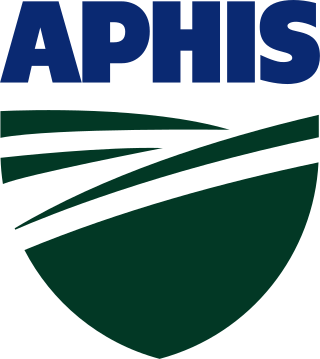Related Research Articles
Biosecurity refers to measures aimed at preventing the introduction and/or spread of harmful organisms to animals and plants in order to minimize the risk of transmission of infectious disease. In agriculture, these measures are aimed at protecting food crops and livestock from pests, invasive species, and other organisms not conducive to the welfare of the human population. The term includes biological threats to people, including those from pandemic diseases and bioterrorism. The definition has sometimes been broadened to embrace other concepts, and it is used for different purposes in different contexts.

The Cartagena Protocol on Biosafety to the Convention on Biological Diversity is an international agreement on biosafety as a supplement to the Convention on Biological Diversity (CBD) effective since 2003. The Biosafety Protocol seeks to protect biological diversity from the potential risks posed by genetically modified organisms resulting from modern biotechnology.

The Animal and Plant Health Inspection Service (APHIS) is an agency of the United States Department of Agriculture (USDA) based in Riverdale, Maryland responsible for protecting animal health, animal welfare, and plant health. APHIS is the lead agency for collaboration with other agencies to protect U.S. agriculture from invasive pests and diseases. APHIS's PPQ is the National Plant Protection Organization for the U.S., and the agency's head of veterinary services/veterinary Deputy Administrator is the Chief Veterinary Officer of the United States.

Non-tariff barriers to trade are trade barriers that restrict imports or exports of goods or services through mechanisms other than the simple imposition of tariffs. Such barriers are subject to controversy and debate, as they may comply with international rules on trade yet serve protectionist purposes.
The Australia – United States Free Trade Agreement (AUSFTA) is a preferential trade agreement between Australia and the United States modelled on the North American Free Trade Agreement (NAFTA). The AUSFTA was signed on 18 May 2004 and came into effect on 1 January 2005.

The Codex Alimentarius is a collection of internationally recognized standards, codes of practice, guidelines, and other recommendations published by the Food and Agriculture Organization of the United Nations relating to food, food production, food labeling, and food safety.

The International Plant Protection Convention (IPPC) is a 1951 multilateral treaty overseen by the United Nations Food and Agriculture Organization that aims to secure coordinated, effective action to prevent and to control the introduction and spread of pests of plants and plant products. The Convention extends beyond the protection of cultivated plants to the protection of natural flora and plant products. It also takes into consideration both direct and indirect damage by pests, so it includes weeds. IPPC promulgates International Standards for Phytosanitary Measures (ISPMs).

In international trade, market access refers to a company's ability to enter a foreign market by selling its goods and services in another country. Market access is not the same as free trade, because market access is normally subject to conditions or requirements, whereas under ideal free trade conditions goods and services can circulate across borders without any barriers to trade. Expanding market access is therefore often a more achievable goal of trade negotiations than achieving free trade.
The Agreement on the Application of Sanitary and Phytosanitary Measures, also known as the SPS Agreement or just SPS, is an international treaty of the World Trade Organization (WTO). It was negotiated during the Uruguay Round of the General Agreement on Tariffs and Trade (GATT), and entered into force with the establishment of the WTO at the beginning of 1995. Broadly, the sanitary and phytosanitary ("SPS") measures covered by the agreement are those aimed at the protection of human, animal or plant life or health from certain risks.
The Agreement on Technical Barriers to Trade, commonly referred to as the TBT Agreement, is an international treaty administered by the World Trade Organization. It was last renegotiated during the Uruguay Round of the General Agreement on Tariffs and Trade, with its present form entering into force with the establishment of the WTO at the beginning of 1995, binding on all WTO members.
The Beef Hormone Dispute is one of the most intractable agricultural controversies since the establishment of the World Trade Organization (WTO).

Technical barriers to trade (TBTs), a category of nontariff barriers to trade, are the widely divergent measures that countries use to regulate markets, protect their consumers, or preserve their natural resources, but they also can be used to discriminate against imports in order to protect domestic industries.

The North American Plant Protection Organization (NAPPO), is the phytosanitary standard setting organization recognized by the North American Free Trade Agreement (NAFTA). It was created in 1976 as a regional organization of the International Plant Protection Convention (IPPC) of the Food and Agriculture Organization (FAO) of the United Nations. Previously based in Ottawa, Ontario, it is now headquartered in Raleigh, North Carolina.
National biosecurity in Australia is governed and administered by two federal government departments, the Department of Health and the Department of Agriculture, Fisheries and Forestry. The Biosecurity Act 2015 (C'wealth) and related legislation is administered by the two departments and manages biosecurity risks at the national border. The Act aims to manage biosecurity risks to human health, agriculture, native flora and fauna and the environment. It also covers Australia's international rights and obligations, and lists specific diseases which are contagious and capable of causing severe harm to human health. Each state and territory has additional legislation and protocols to cover biosecurity in their jurisdiction (post-border) including the detection of pests and diseases that have breached the national border.
Plant Protection and Quarantine (PPQ) is one of six operational program units within the Animal and Plant Health Inspection Service (APHIS) of the United States Department of Agriculture (USDA). The PPQ works to safeguard agriculture and natural resources in the U.S. against the entry, establishment, and spread of animal and plant pests, and noxious weeds in order to help ensure the protection of native flora and an abundant, high-quality, and varied food supply.

Phytosanitary certification verifies phytosanitary worthiness. These certificates are used to attest that consignments meet phytosanitary import requirements and are undertaken by a National Plant Protection Organization (NPPO). Under the Agreement on the Application of Sanitary and Phytosanitary Measures and ISPM, a certificate for export or for re-export can be issued only by a public officer who is technically qualified and duly authorized by an NPPO.
In the 1990s, a trade dispute over fresh salmon arose between the Commonwealth nations of Canada and Australia. In 1995, Canada made a complaint to the World Trade Organization, of which both countries are members, about Australia's restriction on imports of fresh salmon, which were part of a quarantine measure for health purposes.
The Agreement on the Application of Sanitary and Phytosanitary Measures governs rules for food safety and animal and plant health standards. The SPS Agreement permits countries to implement measures provided that they are based on science, are applied only to the extent necessary to protect human, animal and plant life or health and do not arbitrarily or unjustifiably discriminate between countries where identical or similar conditions prevail.
Pest risk analysis (PRA) is a form of risk analysis conducted by regulatory plant health authorities to identify the appropriate phytosanitary measures required to protect plant resources against new or emerging pests and regulated pests of plants or plant products. Specifically pest risk analysis is a term used within the International Plant Protection Convention (IPPC) and is defined within the glossary of phytosanitary terms. as "the process of evaluating biological or other scientific and economic evidence to determine whether an organism is a pest, whether it should be regulated, and the strength of any phytosanitary measures to be taken against it". In a phytosanitary context, the term plant pest, or simply pest, refers to any species, strain or biotype of plant, animal or pathogenic agent injurious to plants or plant products and includes plant pathogenic bacteria, fungi, fungus-like organisms, viruses and virus like organisms, as well as insects, mites, nematodes and weeds.
The World Organisation for Animal Health's Terrestrial Animal Health Code (TAHC) implements improvement standards of worldwide animal health and welfare and public health from a veterinary point of view. It includes standards international trade in terrestrial biological specimens and their merchandise. National veterinary authorities use it to provide for early detection of pathogens and to prevent the transfer of same by international trade in animals and animal merchandise, while skirting "unjustified sanitary barriers to trade".
References
- ↑ "International classification of non-tariff measures". United Nations Conference on Trade and Development (UNCTAD). 2019.
 This article incorporates public domain material from Jasper Womach. Report for Congress: Agriculture: A Glossary of Terms, Programs, and Laws, 2005 Edition (PDF). Congressional Research Service.
This article incorporates public domain material from Jasper Womach. Report for Congress: Agriculture: A Glossary of Terms, Programs, and Laws, 2005 Edition (PDF). Congressional Research Service.